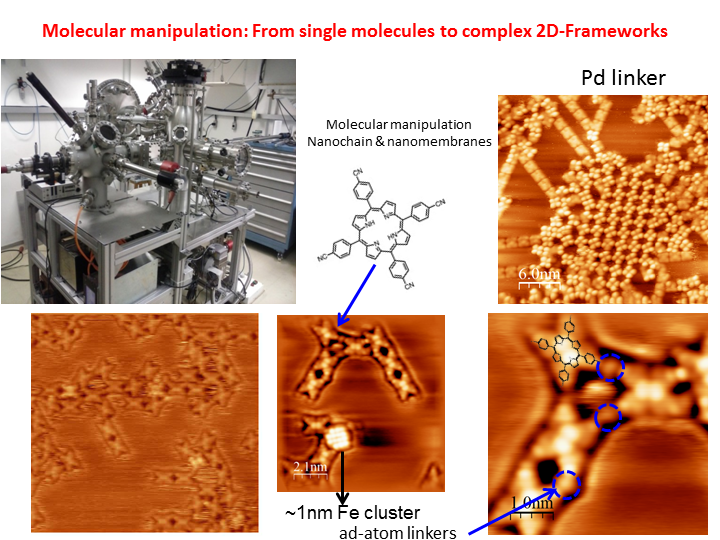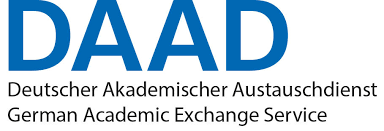Projetos atuais:
1- Molecular self-assembly and functionalization of new molecular architectures based on new porphyrin derivatives.
The study of molecular self-assembling[i] on top of different substrates has gathered the increased attention of the scientific community. The better understanding of different characteristics and the ability to control them at a molecular level has led to quicker and cheaper routes for using the so-called bottom-up approach in nanoscience [1]. Nowadays the combination of modern surface science techniques such as Scanning Tunneling Microscopy (STM) and different types of spectroscopies have allowed a better understanding of fundamental mechanisms of molecular interactions present in common process in chemistry, such as, adsorption geometry, diffusion dynamics, induced chemical reaction and even chemical modification and manipulation of single molecules using the STM tip.
Porphyrins and phtalocyanines are the most studied organic molecules [2]. One important motivation for studying such molecules is their similarities to the ones found in nature’s processes, e.g. chlorophyll and hemoglobin. This means that by studying simple molecules one can try to mimic the natural processes for example to develop gas sensors, catalysts, organic solar cells, among others possible applications.
In this project we want to establish a better understanding of the physical mechanisms of molecular self-assembling and how can it be systematically controlled. The goals in this project are a better understanding of growth, topography, and morphology of surface-template coordination of new porphyrin derivatives as they evolve from 1D wire to 2D monolayer islands to the multilayers and surface supported bulk-like structures [3-5]. The adopted strategy will use the SAM (self-assembling of molecules) mechanism and different substrate-template (such as graphene and vicinal surfaces) to induce the formation of different nanoscale structures, starting with single species at the surface going to more complex systems such as co-assembling of two species. The main investigation techniques used during this project will be room and low-temperature Scanning Tunneling Microscopy, which probes the self-assembly at the real space on the nanometer and atomic scale, synchrotron-based spectroscopies such as Photoelectron Spectroscopy (PES), that allows probing the electronic structures.
- J. V. Barth, G. Costantini and K. Kern, Nature, 2005, 437, 671-679.
- J. Michael Gottfried, Surface Science Reports70, 259–379 (2015).
- F. Buchner, K. Seufert, W. Auwärter, D. Heim, J. V. Barth, K. Flechtner, J. M. Gottfried, H.-P. Steinrück and H. Marbach, ACS Nano, 2009, 3, 1789-1794
- Inverted” Porphyrins: a Distorted Adsorption Geometry of Free-base Porphyrins on Cu (111). Lepper, M., Köbl, J., Schmitt, T., Gurrath, M., de Siervo, A., Schneider, M. A., H.P. Steinrck, B. Meyer, H. Marbach, and Hieringer, W. ; DOI: 10.1039/C7CC04182A (Communication) Chem. Commun., 2017, 53, 8207-8210.
- Shadi Fatayer, Roberto G.A. Veiga, Mauricio J. Prieto, Eric Perim, Richard Landers, Roberto H. Miwa, Abner de Siervo. Self-assembly of NiTPP on Cu(111): a transition from disordered 1D wires to 2D chiral domains, Phys. Chem. Chem. Phys., (2015) 17, 18344-18352.
-
Michael Lepper, Tobias Schmitt, Martin Gurrath, Marco Raschmann, Liang Zhang, Michael Stark, Helen Hölzel, Norbert Jux, Bernd Meyer, M. Alexander Schneider, Hans-Peter Steinrück and Hubertus MarbachJ. Phys. Chem. C, 2017, 121, 26361.
- Jan Kuliga, Rodrigo Cezar de Campos Ferreira, Rajan Adhikari, Stephen Massicot, Michael Lepper, Helen Hölzel, Norbert Jux, Hubertus Marbach, Abner de Siervo, and Hans-Peter Steinrück. “Metalation of 2HTCNPP on Ag(111) with Zn – evidence for the sitting atop complex at room temperature”, ChemPhysChem 22, 396-403 (2021). https://doi.org/10.1002/cphc.202000883
- Rodrigo Cezar de Campos Ferreira, Alejandro Pérez Paz, Duncan John Mowbray, Jean-Yves Roulet, Richard Landers, and Abner de Siervo. “Supramolecular Ordering and Reactions of a Chlorophenyl Porphyrin on Ag(111)”. The Journal of Physical Chemistry C 124 (26) (2020) 14220-14228. DOI: 10.1021/acs.jpcc.0c02953
- Alisson Ceccatto dos Santos, Rodrigo Cezar de Campos Ferreira, Juan Carlos Moreno-López, Lucas Barreto, Michael Lepper, Richard Landers, Hans-Peter Steinrück, Hubertus Marbach, and Abner de Siervo. “Cyano Functionalized Porphyrins on Cu(111) from 1D-Wires to 2D-Molecular Frameworks: on the Role of Co-deposited Metal Atoms”. (SELECIONADO PARA CAPA) Chemistry of Materials (2020) 32, 5, 2114-2122. https://doi.org/10.1021/acs.chemmater.9b05256
- Juan Carlos Moreno-López, Duncan John Mowbray, Alejandro Pérez Paz, Rodrigo Cezar de Campos Ferreira, Alisson Ceccatto dos Santos, Paola Ayala, and Abner de Siervo. “Roles of Precursor Conformation and Adatoms in Ullmann Coupling: An Inverted Porphyrin on Cu(111)”. Chemistry of Materials (2019) 31 (8), 3009-3017. DOI: 10.1021/acs.chemmater.9b00668
- Michael Lepper, Julia Köbl, Liang Zhang, Manuel Meusel, Helen Hölzel, Dominik Lungerich, Norbert Jux, Abner de Siervo, Bernd Meyer, Hans-Peter Steinrück, Hubertus Marbach. “Controlling the Self‐Metalation Rate of Tetraphenylporphyrins on Cu(111) via Cyano Functionalization”. Angew. Chem. Int. Ed.. 57, 10074-10079 (2018) (CAPA INTERNA!). doi: 10.1002/anie.201803601
- Lepper, M.; Koebl, J.; Schmitt, T.; Gurrath, M.; Siervo, A. d.; Schneider, M. A.; Steinrueck, H.-P.; Meyer, B.; Marbach, H.; Hieringer, W., “Inverted” Porphyrins: a Distorted Adsorption Geometry of Free-base Porphyrins on Cu(111). Chem. Commun. 53, 8207-8210 (2017). DOI: 10.1039/c7cc04182a
- Fatayer, S.; Veiga, R. G. A.; Prieto, M. J.; Perim, E.; Landers, R.; Miwa, R. H.; de Siervo, A., Self-assembly of NiTPP on Cu(111): a transition from disordered 1D wires to 2D chiral domains. Physical Chemistry Chemical Physics (2015), 17 (28), 18344-18352. DOI: 10.1039/c5cp01288k
| Campinas Team | External Collaborators |
| Prof. Abner de Siervo
Rodrigo C. C. Ferreira (PhD student) Nataly Zaribeth Herrera Reinoza (PhD student) Alisson Ceccatto dos Santos (Master Student) Prof. Richard Landers |
Prof. Hubertus Marbach (FAU – Erlangen)
Michael Lepper (FAU-Erlangen) Prof. Lucas Barreto (UFABC) Juan Carlos Moreno-Lopez (Uni-Vienna) Duncan John Mowbray (Yachay Tech University, Ecuador) Alejandro Pérez Paz (Yachay Tech University, Ecuador) |





